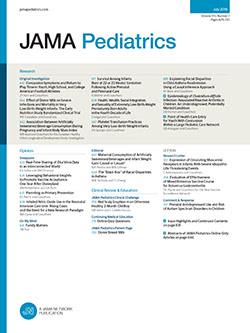Community Health Workers Linking Clinics and Schools and Asthma Control
IF 24.7
1区 医学
Q1 PEDIATRICS
引用次数: 0
Abstract
ImportanceChildhood asthma is characterized by pervasive disparities, including 3-fold higher hospitalization rates and 7-fold higher death rates for Black children compared with White children. To address asthma disparities, one must intervene in all lived environments.ObjectiveTo determine if a community health worker (CHW) intervention to connect the primary care, home, and school for low-income minoritized school-aged children with asthma and their caregivers improves asthma control.Design, Setting, and ParticipantsThis study was a hybrid effectiveness/implementation trial using a 2 × 2 factorial, cluster randomized clinical trial design of 36 schools crossed with participant-level randomization into a clinic-based CHW intervention. The study was conducted from May 2018 to June 2022. The intervention took place in primary care offices, homes, and 36 West Philadelphia, Pennsylvania, public and charter schools. Children aged 5 to 13 years with uncontrolled asthma were recruited from local primary care practices.InterventionsAsthma management, trigger remediation, and care coordination occurred in school, home, and primary care settings. Children were followed up for 12 months. The Yes We Can Children’s Asthma Program, Open Airways For Schools Plus, and school-based asthma therapy were implemented.Main Outcomes and MeasuresImprovement in asthma control, as measured by the Asthma Control Questionnaire, comparing the mean difference between groups 1 year after randomization with their baseline (difference in differences). Both primary care and school interventions were dramatically disrupted by the COVID-19 pandemic; therefore, stratified analyses were performed to assess per-protocol intervention efficacy before the pandemic disruptions.ResultsA total of 1875 participants were approached, 1248 were excluded, and 1 was withdrawn. The 626 analyzed study participants (mean [SD] age, 8.7 [2.4] years; 363 male [58%]) self-identified as Black race (96%) and non-Hispanic ethnicity (98%). Although all groups had statistically significant improvements in asthma control from baseline to 12 months (P− group: −0.46; 95% CI, −0.58 to −0.33; P+ group: −0.57; 95% CI, −0.74 to −0.44; S− group: −0.47; 95% CI, −0.58 to −0.35; S+ group: −0.59; 95% CI, −0.74 to −0.44), none of the difference-in-differences estimates from the primary prespecified models showed a clinically meaningful improvement in asthma control. Analysis from the prepandemic interval, however, demonstrated that children in the combined clinic-school intervention had a statistically significant improvement in asthma control scores compared with control (−0.79; 95% CI, −1.40 to −0.18).Conclusions and RelevanceThis randomized clinical trial provides preliminary evidence that connecting all lived environments for care of children can be accomplished through linkages with CHWs.社区保健工作者将诊所和学校与哮喘控制联系起来
重要性儿童哮喘的特点是普遍存在差异,其中黑人儿童的住院率是白人儿童的 3 倍,死亡率是白人儿童的 7 倍。要解决哮喘差异问题,必须在所有生活环境中进行干预。目标确定社区保健员(CHW)干预是否能改善低收入少数族裔学龄哮喘儿童及其照顾者的哮喘控制,从而将初级保健、家庭和学校连接起来。设计、设置和参与者本研究是一项混合有效性/实施试验,采用 2 × 2 方阵、群组随机临床试验设计,36 所学校交叉进行,参与者水平随机进入基于诊所的 CHW 干预。研究于 2018 年 5 月至 2022 年 6 月进行。干预在宾夕法尼亚州西费城的初级保健诊所、家庭以及 36 所公立和特许学校中进行。干预措施哮喘管理、触发补救和护理协调在学校、家庭和初级保健机构进行。对儿童进行了为期 12 个月的随访。主要结果和测量指标哮喘控制情况的改善,以哮喘控制问卷为衡量标准,比较随机分组 1 年后与基线的平均差异(差异中的差异)。由于 COVID-19 大流行,初级保健和学校干预都受到了极大影响;因此,我们进行了分层分析,以评估大流行影响前按协议干预的效果。分析的 626 名研究参与者(平均 [SD] 年龄为 8.7 [2.4] 岁;363 名男性 [58%])自我认同为黑人(96%)和非西班牙裔(98%)。尽管从基线到 12 个月期间,所有组别在哮喘控制方面都有统计学意义上的显著改善(P 组:-0.46;95% C 组:-0.46;95% C 组:-0.46P- 组:-0.46;95% CI,-0.58 至 -0.33;P+ 组:-0.57;95% CI,-0.58 至 -0.33):P+组:-0.57;95% CI,-0.74 至 -0.44;S-组:-0.47;95% CI,-0.74 至 -0.44):-0.47;95% CI,-0.58 至 -0.35;S+ 组:S-组:-0.47;95% CI,-0.58 至 -0.35;S+组:-0.59;95% CI,-0.74 至 -0.44),主要预设模型的差异估计值均未显示哮喘控制有临床意义的改善。然而,对预设流行区间的分析表明,与对照组相比,接受诊所-学校联合干预的儿童哮喘控制评分有显著的统计学改善(-0.79;95% CI,-1.40 至 -0.18)。
本文章由计算机程序翻译,如有差异,请以英文原文为准。
求助全文
约1分钟内获得全文
求助全文
来源期刊

JAMA Pediatrics
PEDIATRICS-
CiteScore
31.60
自引率
1.90%
发文量
357
期刊介绍:
JAMA Pediatrics, the oldest continuously published pediatric journal in the US since 1911, is an international peer-reviewed publication and a part of the JAMA Network. Published weekly online and in 12 issues annually, it garners over 8.4 million article views and downloads yearly. All research articles become freely accessible online after 12 months without any author fees, and through the WHO's HINARI program, the online version is accessible to institutions in developing countries.
With a focus on advancing the health of infants, children, and adolescents, JAMA Pediatrics serves as a platform for discussing crucial issues and policies in child and adolescent health care. Leveraging the latest technology, it ensures timely access to information for its readers worldwide.
 求助内容:
求助内容: 应助结果提醒方式:
应助结果提醒方式:


